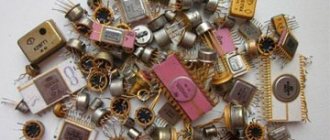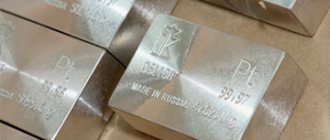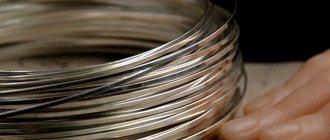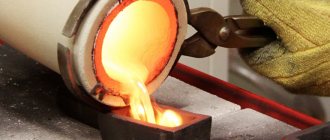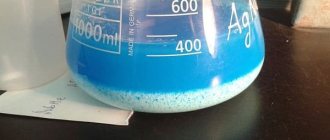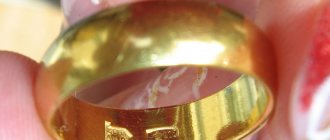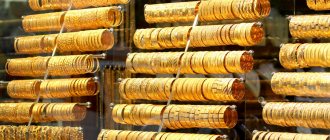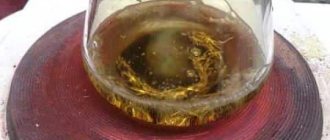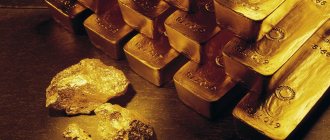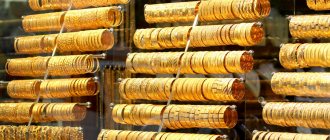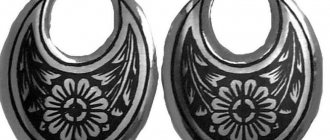Refining is the purification of metal from impurities.
This process consists of a series of sequential processes for separating excess components by physical and chemical means.
Some of the refining methods used in industry can be implemented at home, but sometimes the costs of carrying out the reactions exceed the profit from the resulting noble metal.
In this article we will tell you how to remove and separate gold from radio components and get it out of microcircuits, how to do it safely with your own hands.
Where is this precious metal found?
Hundreds of tons of gold are used annually in the production of radio components and computer chips. Contacts made of this metal are characterized by high electrical conductivity, they are not subject to oxidation, and therefore are widely used.
Gold
is contained in the following components :
- diodes;
- transistors;
- glass electrodes;
- relay;
- ports;
- jumpers;
- motherboard memory modules.
Note that in practice there may be much less gold in radio components than there should be according to documents (especially in technical products made after 1989).
Amalgam
The amalgamation process is also used in industry, only when working with ores and hard rocks. Its essence lies in the ability of mercury to form an amalgam - an intermetallic compound. Strictly speaking, mercury does not dissolve gold in this process: it remains in solid form in the amalgam.
During amalgamation, the rock is wetted with liquid mercury. However, the process of “pulling” gold into amalgam is long, dangerous (mercury vapor is poisonous) and ineffective, so this method is rarely used anywhere.
Methods for removing impurities
The main method of isolating pure metal from mixtures, including from various radio components, is chemical refining . It is very common to dissolve it in aqua regia (a mixture of nitric and hydrochloric acid), followed by passing through a filter and reduction.
Electrolysis method
With the electrolysis method, gold from radio components or any other gold exposed to sulfuric or hydrochloric acid is deposited on the cathode when an electric current passes through the solution.
In industry, a cathode made of already purified gold is used; at home, you can use iron or lead .
A drop in current is a signal that the dissolution process is complete. This method is also effective and therefore quite common.
Cleansing with iodine
To etch gold from the surface of radio components, the most common pharmaceutical Lugol's solution is used - it is a mixture of iodine and potassium iodide. During the reaction, complex anions containing gold molecules are formed.
To increase speed, chemists add sulfuric or nitric acid . The dissolution process can continue for days. Subsequently, the noble metal is precipitated from the solution in different ways.
Using bleach "Whiteness"
Popular household bleach consists primarily of sodium hypochloride.
This substance, when mixed with hydrochloric acid, produces chlorine , which is subsequently used to dissolve gold to form gold chloride.
After this, sodium bisulfate is added .
At the end of the reaction, gray particles remain at the bottom of the vessel - this is gold, which will acquire a natural color after remelting.
Another option is to mix White, table salt (sodium chloride) and battery electrolyte, which is nothing more than sulfuric acid. The hypochlorous acid obtained during the reaction dissolves gold - it must be reduced in the future .
Refining "without acid"
Recipes spread on the Internet for obtaining gold from radio components and dissolving gold “without acid” essentially mislead readers, since acid (usually hydrochloric acid) is formed as a result of the reaction of other substances .
In addition, not everyone knows that the battery electrolyte used in such cases is also an acid.
Using Hydrogen Peroxide
The extraction of gold from radio components using hydrogen peroxide is carried out as follows.
This substance, otherwise called perhydrol, reacts with hydrochloric acid, dissolving gold. To do this, gold-containing raw materials are poured with acid and peroxide is added.
The resulting chloroauric acid is further decomposed into elements .
To do this, you can use a thermal method (point a blue flame of a burner at the substance) or a chemical one. The latter consists of reducing gold by adding ferrous sulfate.
Other extraction methods
There are many other refining methods that can be used to collect gold from chips, such as electrolyte and ammonium nitrate.
In this case, the electrolyte is mixed with ammonium nitrate - the so-called salt of nitric acid. The resulting composition is capable of dissolving the noble metal.
Most other methods also based on the dissolution of gold and its subsequent reduction .
The processes differ according to:
- cost;
- availability of components;
- reaction speed.
Raw materials for refining processing
To obtain refined gold, they work with certain raw materials. These are gold-containing materials:
- Natural mixtures containing precious metal. It can be minerals, rocks and even river sand.
- Scrap gold. Used gold items and elements. For example, jewelry scrap includes earrings, rings, chains, bracelets, pendants, and brooches. Technical – radio engineering waste, radio components, microcircuits. Household scrap - coins, dishes, watches, badges, medals. This also includes some types of bladed weapons (sabers, swords, daggers), souvenirs and antiques.
- Waste after purification of medical alloy. For example, gold plating applied by gilding.
- Lead production concentrates. Lead contains noble metals - gold and silver. To separate them, zinc is used. When heated, it forms a silvery foam, which picks up precious metals and is separated from the lead.
- Rough gold. This type of raw material makes up the largest share subject to refining. This is all the precious metal mined. It goes to processing plants, where it undergoes refining treatment.
Placer gold
As you can see, gold is not only a product of extraction in mines. Noble metal is present in the life of every person: in jewelry and household items.
Step-by-step instructions for extracting metal from radio components and microcircuits
To extract gold from microcircuits and radio components, it is advisable to use aqua regia .
To refine gold using this method, you must perform the following steps :
- grind the components mechanically, separating the parts that contain gold;
- get rid of organic matter by burning or calcining;
- open the windows in the room for better ventilation;
- for experiments, prepare a vessel made of borosilicate glass;
- place the workpieces in a concentrated mixture of 36% hydrochloric acid (3 parts) and 95% nitric acid (1 part) in small portions - up to 3 grams at a time, 500 ml of aqua regia will be required per 100 g of raw materials;
- Heat the solution while gradually adding nitric acid;
- check the presence of gold with tin chloride;
- filter the solution, then remove nitric acid from it.
Gold can subsequently be reduced using ferrous sulfate, perhydrol, oxalic acid or hydrazine sulfate. The resulting gold is smelted into an ingot using a crucible .
Note that it is unsafe to purify gold at home due to the significant causticity and toxicity of the substances used and the volatile compounds released.
In addition, advanced knowledge of chemistry will be required.
Other halogens
In addition to chlorine, other elements of the seventh group of the periodic table also oxidize gold well. It is difficult to fully say about them: “that in which gold dissolves.”
Gold can react with fluorine in different ways: during direct synthesis (at a temperature of 300-400°C), gold fluoride III is formed, which immediately hydrolyzes in water. It is so unstable that it decomposes even when exposed to hydrofluoric acid, although it should be comfortable among fluoride ions.
Also, by the action of the strongest oxidizing agents: fluorides of noble gases (krypton, xenon), gold fluoride V can be obtained. Such fluoride generally explodes upon contact with water.
With bromine, things are somewhat simpler. Bromine is a liquid under normal conditions, and gold dissipates well in its solutions, forming soluble gold bromide III.
Gold also reacts with iodine when heated (up to 400°C), forming gold iodide I (this degree of oxidation is explained by the lower activity of iodine compared to other halogens).
Thus, gold certainly reacts with halogens, but whether gold dissolves in them is controversial.
Where to deliver the received material and at what price?
The gold ingot (barrel) obtained as a result of purification most often has insignificant weight. However, even in such quantities it is of interest to buyers.
Advertisements for buying gold can be easily found on the Internet or in local newspapers.
Often, solid metal is purchased by the same companies that buy radio components.
(for example, aluminum or brass) may also be interested in gold
If the buyer is in the same city as the seller, the transaction is completed upon visiting the specified address.
The buyer himself weighs the metal and checks its quality, after which he sets a price. Of course, if possible, it is advisable to check all offers on the market in order to choose the most profitable one. The bullion can be sent to another city by mail, cash on delivery.
Some pawnshops are also ready to accept goods of this kind. To find out at what price the establishment will be willing to purchase gold, contact a pawnshop employee. Another option is to submit an ad yourself . In this case, you just have to wait for a call from a potential buyer.
If you engage in refining on an industrial scale, you should rely on existing laws.
To legally engage in the circulation of precious metals, you need to register as an individual entrepreneur or create an LLC.
When selling gold, focus on its purity and market value.
The price per gram of 999 fine precious metal is set by the Central Bank of Russia . Since 2004, its prices have been continuously rising. The most significant jump was observed in 2016, when the cost exceeded 3 thousand rubles per gram.
What does gold refining mean in jewelry?
So, what is gold refining? This is the name of the metal cleaning process. Not external cleaning, when the product is restored to its former cleanliness and shine. Refining or refining is the removal of additional impurities from gold. This process can also be called refining. Refined gold, like sugar, is a perfectly purified element.
Refining of mined gold at a factory
For example, during mining it is difficult to find perfectly pure gold bars. Most often these are grains mixed with other rocks or just earth. It is also important to know that precious metals, such as gold and silver, are mined from the same ores. Therefore, they are always present in each other’s impurities.
The mined precious metal is processed at the plant, where it is refined.
The result is the production of refined gold - a metal of 999.9 purity.
Accordingly, the gold products used also have additional impurities – other metals. Therefore they need to be refined. So, from jewelry of 585 standard it is quite possible to get 999 standard.
Refined silver
To refining silver precious metal, electrolytic and chemical methods are used, as well as the cupellation method.
In apartment conditions, to obtain refined silver metal, it is possible to use only the chemical method. In this case, silver is released from the solution in the form of sulfate, which has a black color. If you add ammonium chloride or ordinary table salt to the solution, the metal can be obtained in the form of chloride. The resulting liquid substrate is settled until it is separated into cloudy and transparent fractions. The refined silver will need to be recovered from the sediment.
